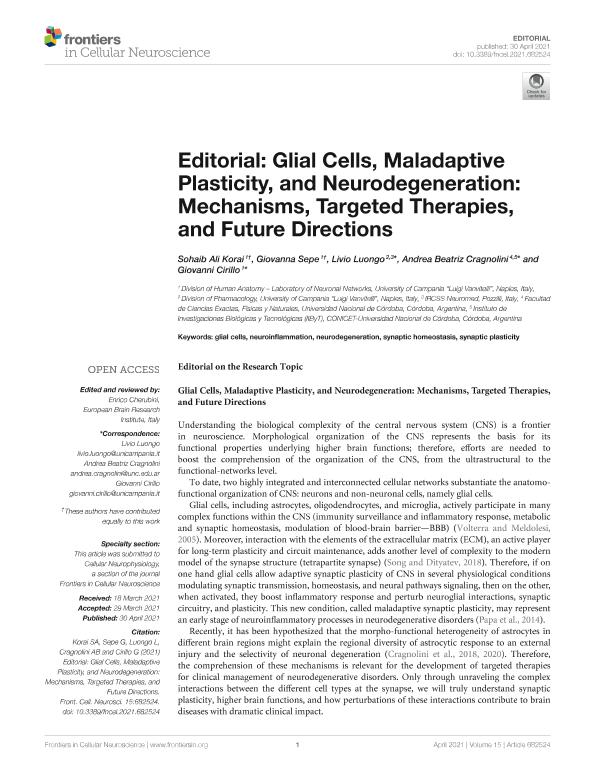Artículo
Editorial: Glial cells, maladaptive plasticity, and neurodegeneration: Mechanisms, targeted therapies, and future directions
Fecha de publicación:
30/04/2021
Editorial:
Frontiers Media S.A.
Revista:
Frontiers in Cellular Neuroscience
ISSN:
1662-5102
Idioma:
Inglés
Tipo de recurso:
Artículo publicado
Clasificación temática:
Resumen
Understanding the biological complexity of the central nervous system (CNS) is a frontier in neuroscience. Morphological organization of the CNS represents the basis for its functional properties underlying higher brain functions; therefore, efforts are needed to boost the comprehension of the organization of the CNS, from the ultrastructural to the functional-networks level.To date, two highly integrated and interconnected cellular networks substantiate the anatomofunctional organization of CNS: neurons and non-neuronal cells, namely glial cells. Glial cells, including astrocytes, oligodendrocytes, and microglia, actively participate in many complex functions within the CNS (immunity surveillance and inflammatory response, metabolic and synaptic homeostasis, modulation of blood-brain barrier?BBB) (Volterra and Meldolesi, 2005). Moreover, interaction with the elements of the extracellular matrix (ECM), an active player for long-term plasticity and circuit maintenance, adds another level of complexity to the modern model of the synapse structure (tetrapartite synapse) (Song and Dityatev, 2018). Therefore, if on one hand glial cells allow adaptive synaptic plasticity of CNS in several physiological conditions modulating synaptic transmission, homeostasis, and neural pathways signaling, then on the other, when activated, they boost inflammatory response and perturb neuroglial interactions, synaptic circuitry, and plasticity. This new condition, called maladaptive synaptic plasticity, may represent an early stage of neuroinflammatory processes in neurodegenerative disorders (Papa et al., 2014). Recently, it has been hypothesized that the morpho-functional heterogeneity of astrocytes in different brain regions might explain the regional diversity of astrocytic response to an external injury and the selectivity of neuronal degeneration (Cragnolini et al., 2018, 2020). Therefore, the comprehension of these mechanisms is relevant for the development of targeted therapies for clinical management of neurodegenerative disorders. Only through unraveling the complex interactions between the different cell types at the synapse, we will truly understand synaptic plasticity, higher brain functions, and how perturbations of these interactions contribute to brain diseases with dramatic clinical impact.
Archivos asociados
Licencia
Identificadores
Colecciones
Articulos(IIBYT)
Articulos de INSTITUTO DE INVESTIGACIONES BIOLOGICAS Y TECNOLOGICAS
Articulos de INSTITUTO DE INVESTIGACIONES BIOLOGICAS Y TECNOLOGICAS
Citación
Korai, Sohaib Ali; Sepe, Giovanna; Luongo, Livio; Cragnolini, Andrea Beatriz; Cirillo, Giovanni; Editorial: Glial cells, maladaptive plasticity, and neurodegeneration: Mechanisms, targeted therapies, and future directions; Frontiers Media S.A.; Frontiers in Cellular Neuroscience; 15; 682524; 30-4-2021; 1-4
Compartir
Altmétricas




